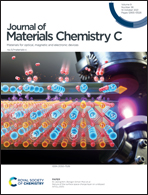Magnetocaloric Ln(HCO2)(C2O4) frameworks: synthesis, structure and magnetic properties†
Abstract
This study probes the structure and the magnetic properties of members of the Ln(HCO2)(C2O4) (Ln = Sm3+–Er3+) family of coordination frameworks. These frameworks adopt Pnma orthorhombic symmetry with one-dimensional chains arranged on a distorted triangular lattice. The magnetic properties of the Gd–Ho members of this series indicate they remain paramagnetic down to 2 K, with Dy(HCO2)(C2O4) magnetically ordering at 0.6 K. The magnetocaloric effect of Gd(HCO2)(C2O4) is amongst the highest found in frameworks with a peak entropy change of 55.97 J kg−1 K−1 (218.42 mJ cm−3 K−1) for a 5–0 T field change at Tmax = 2 K, making this material a very good candidate for ultra-low temperature magnetic cooling. In contrast with related magnetocaloric materials lanthanides with high magnetocrystalline anisotropy do not generally improve the magnetocaloric performance of this family at higher temperatures and lower fields. Neutron diffraction experiments suggest that Tb(HCO2)(C2O4) and Ho(HCO2)(C2O4) lack significant local magnetic correlations, highlighting the key role these play in optimising the magnetocaloric performance in low fields in related phases; this emphasises the importance of designing materials with specific magnetic interactions to optimise magnetocaloric performance.



 Please wait while we load your content...
Please wait while we load your content...